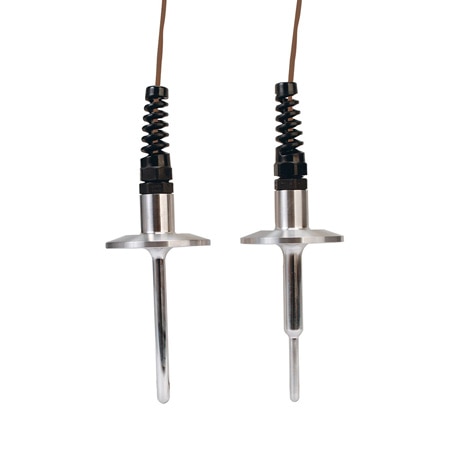Sanitary Temperature Sensor Specifications Include: 316L stainless steel process wetted surfaces with surface finishes of 32 microinches or better. Probe lengths of 3, 4, 5 or 6 inches available from stock, other lengths available as special orders. Sensor Output is a 4-wire, 100 ohm, Class A, Platinum RTD meeting the requirements of IEC 60751. These sensors can be used with 2-wire or 3-wire systems see information below. Insulation resistance: 100 megohms minimum at 100 VDC. Thermal response time of less than 2.5 seconds in water flowing at 3 ft/sec (63% response). This Sanitary Temperature Sensor containes a
PT100 Platinum RTD element and is designed for use in
Food, Dairy, Beverage and BioPharmaceutical Clean-In-Place (CIP) type applications. The sensor includes a
1½" 16AMP process connection that conforms to
ASME BPE-2007 for easy installation using
industry standard gaskets and clamps.
Standard Duty sensors are available with ¼" diameter probes, and
Heavy Duty sensors are available with a stepped
3⁄
8" to
3⁄
16" diameter probe. This sensor is provided with a 120" long, 4-conductor, #26AWG stranded nickel plated copper, PFA insulated and jacketed cable with a strain relief for convenient connection to control or monitoring equipment.
Food process hygienic temperature sensors can be used to aid food safety inspection compliance and verification of time temperature control. Combined with a chart recorder model CTXL you can temperature monitor a CCP ( Critical Control Point) or sanitation time and move toward a HACCP (Hazard Analysis Critical Control Point) compliance plan.
In addition to the
standard 1½-16AMP process connection, these can be provided in the following sizes and styles:
| Process Connection | Model Number Code |
|---|
| 3/4"-16AMP | -B1- |
| 1" and 1½"-16AMP | -D1- |
| 2"-16AMP | -E1- |
| 2½"-16AMP | -F1- |
| 3"-16AMP | -G1- |
| 4"-16AMP | -H1- |
If you need a process connection that is not listed above, please contact our sales department for availability.
These sanitary sensors are supplied standard as 4-wire assemblies with two red wires and two white wires.
When used in 3-wire applications, cut off one white wire making sure that it will not contact any terminals or metal surfaces (note: twisting the two white wires together will reduce the lead wire resistance on one side of the sensing element by half adversely affecting the accuracy of the reading).
When used in 2-wire applications, cut off one white wire and one red wire (note: in 2-wire applications, twisting the two same-colored wires together at the terminals will not adversely affect your sensor accuracy since both wires will be affected by the reduction in resistance).
These sensors are
also available in THS-h-CB">Thermistor and TCS-H-CB">Thermocouple styles to accommodate any process input requirement.
